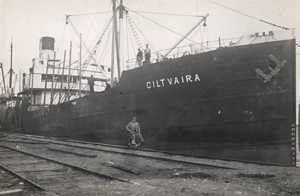Ciltvaira's
biography
 |
| This picture was taken
of the Ciltvaira about 1939 during one of its
last calls to homeport in Riga, Latvia before
leaving never to return. Photo Courtesy Of Chas
Daily/Private Collection Of Dmitry Dmitriev,
Riga,
Latvia | | The eight Latvian ships -- Ciltvaira,
Everasma, Abgara, Everalda, Regent, Everelza, Kegums and
Everagra -- that made up the small fleet operating under
the authority of that country's government in exile
during World War II shared more than just the Latvian
flag.
They were built between 1903 and 1921 in
Britain by J.L. Thompson and Sons, Ltd., said Joseph
Schwarzer, director of the Graveyard of the Atlantic
Museum in Hatteras.
After WWII, one of the two
remaining ships, the Kegums, was renamed the Everest
when it was returned to Latvia in 1946. The other ship
that survived [name unknown] was sold to Honduras that
same year.
Remarkably, although six of the ships
were sunk in various parts of the Atlantic Ocean, by the
end of the war, said Schwarzer, there were only two
prisoners of war and a total of 34 deaths. The average
crew size was 34 members.
The Ciltvaira, sunk off
Nags Head Jan. 19, 1942, took her fourth name to the
bottom.
Owned by Johann Feymann, Janis Salemans
and Karlis Jansons, the single-screw steam-powered
freighter was named the Endsleigh from 1905 to 1907, the
President Bunge from 1907 to 1924 and the Twyford from
1924 to 1935, when it was changed to
Ciltvaira.
The 346.7-foot-long Ciltvaira could
travel up to 8.5 knots. Its beam was 50 feet 10 inches,
gross tonnage was 3,379 and dead weight was 6,249 tons.
It had a draft of 21 feet 5 inches.
Although it is held that the ship
sunk off shore of Nags Head, Bill McDermott, owner of
Outer Banks Dive Center, said that the exact location is
still a mystery. Divers have long held that the "green
buoy" wreck is that of the Ciltvaira, but McDermott said
that that wreck has a gun turrent and photographs taken
right before the Ciltvaira sunk shows it didn't have
one.
-Sandy Semans
|

